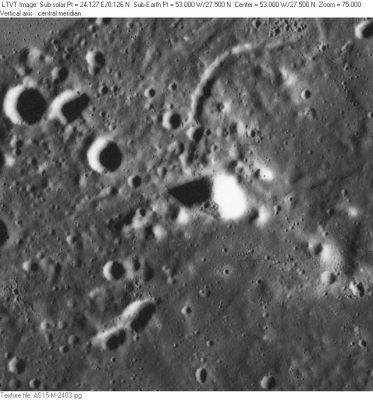Mons Herodotus
Contents
[hide]Mons Herodotus
|
Lat: 27.5°N, Long: 53.0°W, Diam: 5 km, Height: km, Rükl: 18 |
Apollo 15 image AS15-M-2483 The rille flowing north from Mons Herodotus (the shadow-casting peak) does not have an official name.
Images
LPOD Photo Gallery Lunar Orbiter Images Apollo Images
- Lunar Orbiter 5's frame 206-h2 shows a close-up of Mons Herodotus. - DannyCaes Mar 22, 2014
A survey of orbital Hasselblad photographs made during the mission of Apollo 15, showing Mons Herodotus (research: Danny Caes).
- AS15-88-11982 (Low Res) is an orbital color Hasselblad of Montes Agricola during local sunrise. Mons Herodotus is the bright "spot" with spike-shaped shadow on the somewhat rough-looking terrain of the Aristarchus Plateau (lower right corner). North is upward.
- Medium Resolution scan of AS15-88-11982 (source: Kipp Teague/ Project Apollo Archive).
- High Resolution scan of AS15-88-11982 (source: Kipp Teague/ Project Apollo Archive).
- AS15-95-12976; which is an orbital black-and-white Hasselblad, shows a vertical close-up view of Mons Herodotus. North is to the right, sun is shining from the east ("upward").
- AS15-93-12622; an orbital color Hasselblad, shows Mons Herodotus just above the lower right corner of the photograph. The central wrinkle ridge is Dorsum Niggli, near Montes Agricola (left part of frame). North is to the left, sun is shining from the east ("downward").
- AS15-90-12315; another orbital black-and-white Hasselblad shows Mons Herodotus near the lower right corner of the photograph. North is toward the upper left corner, the sun is shining "from the upper right corner".
- AS15-90-12271 shows an oblique westward view of the Aristarchus Plateau, on which Mons Herodotus is noticeable as a "white spot" above centre of photograph. North is to the right, sun is shining "upward".
- AS15-90-12309 shows Mons Herodotus just above centre of the photograph's bottom edge.
- AS15-98-13328 is a vertical overexposed view of Mons Herodotus and its shadow (near the centre of the photograph's bottom edge).
A survey of orbital Metric Fairchild photographs made during the mission of Apollo 15, showing Mons Herodotus (research: Danny Caes).
- Revolution 60 shows vertical views of Mons Herodotus shortly after local sunrise, with very long spiky shadow (see frames 2086 to 2090).
- Revolution 62 shows vertical views of Mons Herodotus in local morning light (see frames 2200 to 2203).
- Revolution 63 shows vertical views of Mons Herodotus in local morning light (see frames 2344 to 2347).
- Revolution 70 shows vertical views of Mons Herodotus in local morning light, with short shadow (see frames 2482 to 2485).
- Revolution 71 shows southward-looking views of Mons Herodotus, with short shadow (see frames 2611 to 2614).
A survey of orbital panoramic ITEK photographs made during the mission of Apollo 15, showing Mons Herodotus (research: Danny Caes).
- Revolution 72 - Forward- AS15-P-10342 shows a close-up of the brightly illuminated eastern side of Mons Herodotus (sun is shining "from below", north is to the right).
- Revolution 72 -Aft- AS15-P-10347 (idem).
Maps
(LAC zone 38B3) LAC map Geologic map LM map LTO map
Description
Description: Wikipedia
Additional Information
- The shadow in AS15-M-2483 indicates a height difference of 1200 m, with the highest point of the peak being near where the three facets meet to the south of center.
Nomenclature
- Named from nearby crater. (Herodotus).
- Is (or was) called Herodotus Chi on Chart 24 in the Times Atlas of the Moon.
- Mons Herodotus was also called the Star-Tip Mountain because of its bright pointlike appearance during local sunrise. This nickname is mentioned in the article ILLUSIONS THAT TRAP LUNAR OBSERVERS by Leland S. Copeland, SKY AND TELESCOPE april 1956 (pages 248-251). See also LPOD of december the 14th, 2008 (the sunlit Star-Tip Mountain photographed by K.C.Pau).
LPOD Articles
Bibliography
